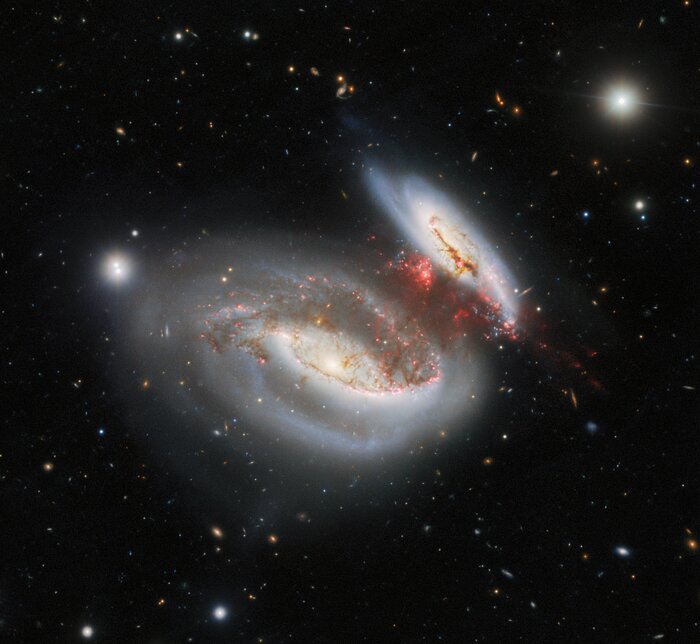Sprawling aftermath of head-on collision between two galaxies

This dazzling image of a galaxy pair, UGC 12914 and UGC 12915, was captured by the Gemini North Telescope, one of two identical 8.1-meter telescopes that make up the International Gemini Observatory, operated by NSF's National Optical-Infrared Astronomy Research Laboratory (NOIRLab).
Nicknamed the Taffy Galaxies, this galactic pair is located about 180 million light-years away in the direction of the constellation Pegasus.
Galaxy collisions are among the most transformative events and they play a significant role in driving the evolution of the universe. When galaxies collide, they bring together vast amounts of gas, dust, and stars, which mix and mingle in a highly dynamic process, which can result in the formation of molecular clouds, which are dense concentrations of gas and dust that provide the perfect environment for star formation.
However, when UGC 12914 (left) and UGC 12915 (right) collided head-on around 25-30 million years ago, a distinct structure was formed - a massive bridge of highly turbulent gas devoid of significant star formation spanning the two galaxies.
When the two galaxies collided, their galactic disks and gaseous components smashed right into each other, resulting in a massive injection of energy into the gas. This caused the gas to become highly turbulent. As the pair emerged from their collision, high-velocity gas was pulled from each galaxy, creating a massive gas bridge between them. The turbulence of the stellar material throughout the bridge is now prohibiting the collection and compression of gas that are required to form new stars, according to NOIRLab's press release.
Cosmic Collision! 🌌 Astronomers using the @GeminiObs North telescope captured this dazzling image of UGC 12914 and UGC 12915, which are nicknamed the Taffy Galaxies. https://t.co/p0JFnVWyTK pic.twitter.com/eswtlzkfsU
— NOIRLab (@NOIRLabAstro) March 29, 2023
Located atop Hawaii‘s Maunakea, the Gemini North telescope is designed to capture high-resolution images and spectra of celestial objects in the northern hemisphere. Its twin, Gemini South, is located on a mountain in the Chilean Andes called Cerro Pachón.
- READ MORE ON:
- Taffy Galaxies
- Gemini North Telescope










